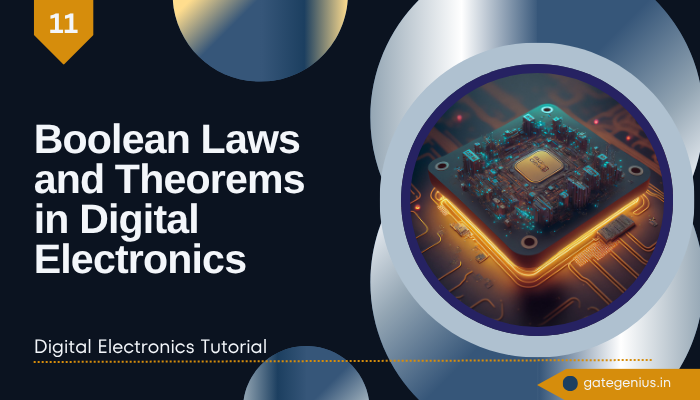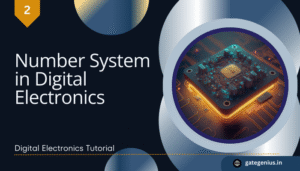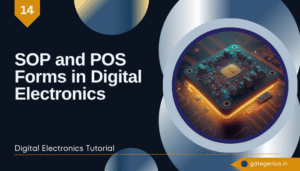Understanding Boolean Laws and Theorems in Digital Electronics is essential for simplifying and analyzing logic circuits effectively. Boolean Algebra provides a set of rules that allow us to reduce complex logical expressions into simpler, more efficient forms. These laws and theorems are not only theoretical but have practical applications in designing real-world digital circuits such as processors, memory units, and control systems.
In this blog, we’ll explore the key Boolean laws and theorems, explain their importance, and see how they are used in Digital Electronics.
Basic Boolean Laws
Boolean Laws in Digital Electronics are a set of logical principles that govern the behavior of binary variables using AND, OR, and NOT operations. These laws form the foundation of logic circuit design and are widely used to reduce complex expressions and optimize digital circuits. By applying these laws, digital designers can simplify circuit behavior and improve overall system performance.
1. Identity Law
Expression:
A + 0 = A
A . 1 = A
This law states that when 0 is added (ORed) to any variable, or when a variable is ANDed with 1, the output remains the same as the input variable. This law helps maintain the identity of the variable and is commonly used to simplify logic expressions without altering their functionality.
2. Null (Dominance) Law
Expression:
A + 1 = 1
A . 0 = 0
According to the Null Law, if any variable is ORed with 1, the output will always be 1. Similarly, ANDing a variable with 0 will always result in 0. This law is very useful in identifying conditions where the output is predetermined, regardless of the variable’s value. It is frequently used to optimize circuits during simplification in Boolean Algebra in Digital Electronics.
3. Idempotent Law
Expression:
A + A = A
A . A = A
The Idempotent Law states that repeating the same variable through OR or AND operations does not affect the output. This helps in eliminating redundant terms in Boolean expressions, making circuits more efficient. This law plays an important role in both theoretical simplification and practical logic circuit design.
4. Complement Law
Expression:
A + A’ = 1
A . A’ = 0
This law is based on the relationship between a variable and its complement. ORing a variable with its complement yields 1, while ANDing it yields 0. This is a powerful simplification tool in Boolean Algebra in Digital Electronics, often used to cancel out terms and reduce expressions to their simplest form.
5. Double Negation Law
Expression:
(A’)’ = A
The Double Negation Law states that if a variable is negated twice, it returns to its original value. This is especially useful when simplifying expressions that involve multiple layers of NOT operations. It is also crucial for converting logic gate expressions and minimizing circuit complexity in digital design.
Important Boolean Theorems
Theorems in Digital Electronics are powerful logical principles used to simplify and manipulate Boolean expressions. These theorems make it easier to design efficient and cost-effective logic circuits. By understanding and applying these theorems, digital designers can reduce unnecessary logic gates and create more compact, optimized systems.
1. Commutative Law
Expression:
A + B = B + A
A . B = B . A
This theorem states that the order of variables in an OR or AND operation does not affect the output. Whether you write A + B or B + A, the result remains the same. This property is very useful in rearranging terms during Boolean expression simplification in Boolean Algebra in Digital Electronics, especially when preparing expressions for further reduction.
2. Associative Law
Expression:
(A + B) + C = A + (B + C)
(A . B) . C = A . (B . C)
The Associative Law allows you to regroup terms in a Boolean expression without changing its output. This is particularly helpful when dealing with long or nested expressions. In Theorems in Digital Electronics, this law is used to structure Boolean equations for easier simplification or to align terms with a particular logic gate arrangement.
3. Distributive Law
Expression:
A . (B + C) = A . B + A . C
A + (B . C) = (A + B) . (A + C)
This theorem helps distribute one operation over another, such as distributing AND over OR or vice versa. It is essential for expanding or factoring Boolean expressions. In Boolean Algebra in Digital Electronics, the Distributive Law is commonly used when breaking down expressions to implement them using basic logic gates.
4. Absorption Law
Expression:
A + A . B = A
A . (A + B) = A
The Absorption Law shows how some terms can be absorbed into others, allowing for the elimination of redundant components. This significantly reduces the number of gates required in a circuit, making the logic design more efficient. This is especially useful in simplifying expressions for programmable logic devices and memory circuits.
5. De Morgan’s Theorem
Expression:
(A . B)’ = A’ + B’
(A + B)’ = A’ . B’
De Morgan’s Theorem is one of the most crucial theorems in Boolean Algebra in Digital Electronics. It is used to convert an expression involving NAND or NOR gates into one that uses basic gates or vice versa. This theorem is especially important when designing logic circuits with universal gates and is heavily used in optimization techniques and logic gate conversion.
Why Boolean Laws and Theorems Matter
- Ease of Design and Troubleshooting: These simplifications make it easier for engineers to understand, design, and troubleshoot digital systems — from basic switches to complex processors.
- Simplify Complex Circuits: Boolean laws and theorems make it easier to break down and simplify complicated logic circuits into simpler forms.
- Reduce Logic Gates: By applying these rules, designers can lower the number of logic gates required, making the circuit less complex.
- Lower Cost: Fewer gates mean less hardware, which helps reduce manufacturing and material costs.
- Save Physical Space: Simplified circuits take up less space on chips or circuit boards, allowing for more compact designs.
- Decrease Power Consumption: Less hardware also means circuits use less power, improving efficiency and battery life in portable devices.
- Increase Speed: Fewer gates and simpler circuits lead to faster operation and improved overall performance.
Frequently Asked Questions (FAQs)
ChatGPT said:
Q1. What is Boolean Algebra in Digital Electronics?
A1. Boolean Algebra is a mathematical technique used to analyze and simplify digital logic circuits using binary variables (0 and 1).
Q2. Why are Boolean laws important?
A2. They help simplify logical expressions, which leads to efficient and cost-effective digital circuit design.
Q3. What is De Morgan’s Theorem used for?
A3. It is used to transform logic expressions, especially when implementing circuits using only NAND or NOR gates.
Q4. Which laws are used for simplification?
A4. Laws like Identity, Complement, Distributive, and Absorption are commonly used in circuit simplification.
Q5. Can Boolean Algebra reduce power consumption in circuits?
A5. Yes, because simpler circuits use fewer gates, which means less power is consumed.
Conclusion
Boolean Laws and Theorems in Digital Electronics are fundamental concepts that help simplify and optimize logic circuits. These rules guide us in minimizing hardware usage and improving circuit performance. Whether you’re designing a simple logic gate or a complete microprocessor, Boolean Algebra in Digital Electronics is the key to building fast, reliable, and cost-effective systems.
Mastering these laws and applying them in real-world circuit design can significantly boost your understanding of digital electronics. The more you practice, the better you become at simplifying complex logic into efficient solutions.
I hope you understand the Boolean Laws and Theorems in Digital Electronics. So don’t forget to share this post with friends and anyone preparing for the GATE, UGC NET exams, or studying at the university.



